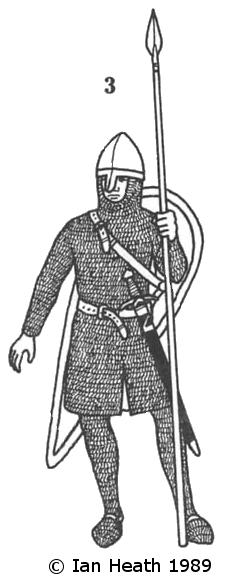
Try Amazon Audible Premium Plus and Get Up to Two Free Audiobooks
KNIGHT c.1160
An extract from Armies of Feudal Europe 1066-1300by Ian Heath


3. KNIGHT c.1160
This figure, from Cagliari Cathedral in Italy, shows little real change from the last, principal difference being the addition of leg-armour. This appears at the very beginning of this era in the Bayeux Tapestry but only seems to have come into widespread use after the mid-12th century. There were two main types, one laced up the back of the leg as depicted in figure 5, the other in the form of a mail stocking drawn up to a waist-belt worn under the tunic. Such leg-pieces were called chausses, or hosen.
The traditional kite-shield remained the predominant type. In fact it was to survive, in more or less modified form, even as late as the 15th century, especially in Italy and Russia. Two virtually intact 12th century examples of such shields which have come down to us are of wood (lime in one instance, cedar in the other) covered on both sides with leather and parchment respectively, with heraldic devices painted on. Prior to alteration in the 13th century the more intact example, that of Arnold von Brienz (d.1225) in the Swiss National Museum, was about 38" deep; it probably dates to the late-12th century. Throughout this era shields were almost invariably suspended by a shoulder-strap, the guige, and held by additional straps (enarmes,) round the wrist and forearm. A leather pad designed to cushion the fist and forearm began to appear on the inside of the shield at about this date.
[Based on The sleeping soldiers at the Resurrection, Pulpit of William, Cagliari Cathedral, 1159-62]